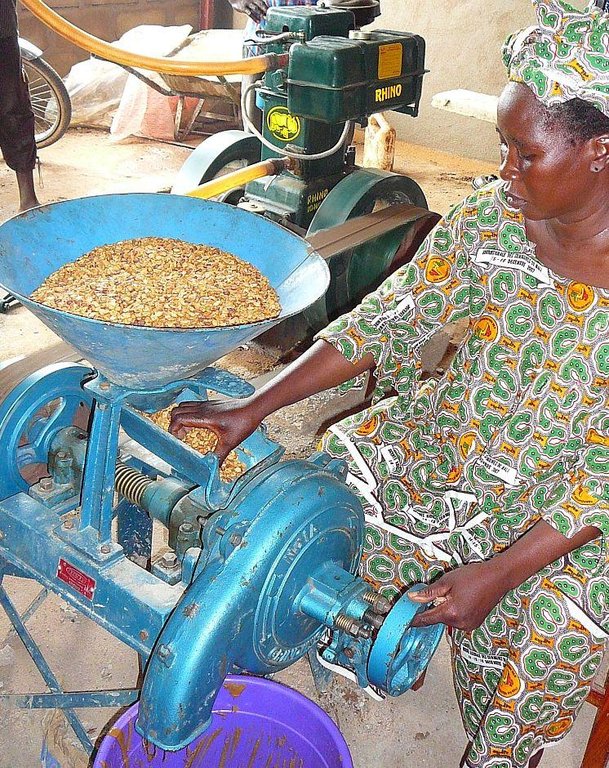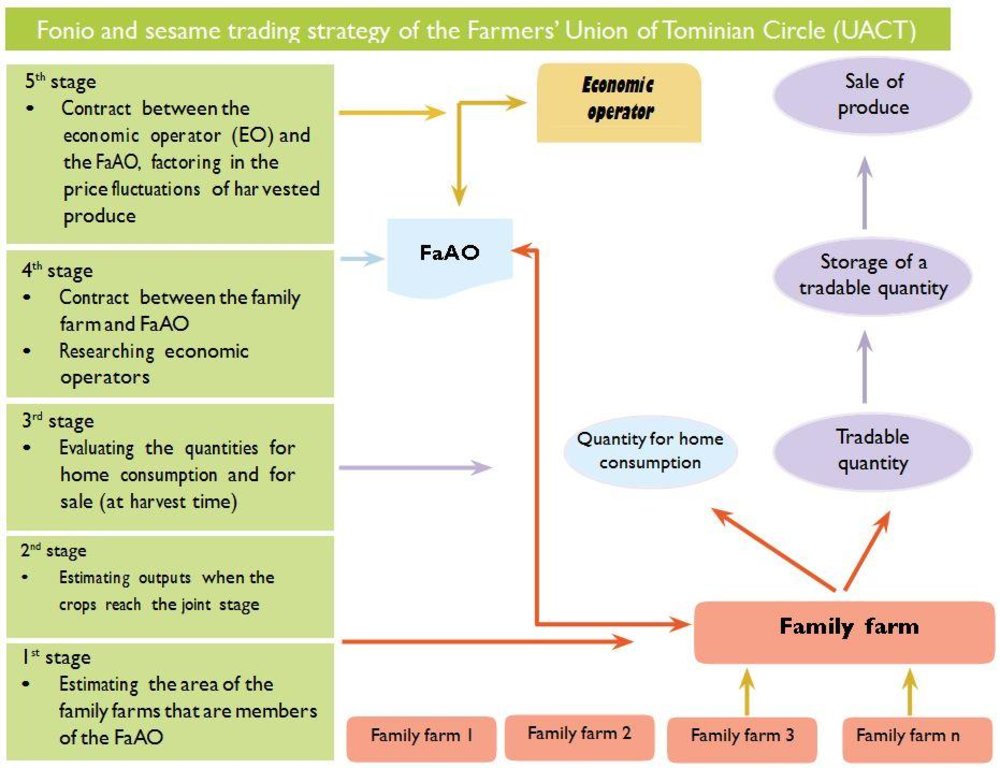Bulk sales approach for farmer apex organisations (FaAO) [Mali]
- Creation:
- Update:
- Compiler: Dieter Nill
- Editor: –
- Reviewer: Laura Ebneter
Approche de commercialisation groupée par des organisations paysannes faitières (OPF))
approaches_2510 - Mali
View sections
Expand all Collapse all1. General information
1.2 Contact details of resource persons and institutions involved in the assessment and documentation of the Approach
SLM specialist:
Dacko Maïga Rosaline
rosaline.dacko@helvetas.org
HELVETAS - Swiss Intercooperation
Mali
SLM specialist:
Keita Lassana
lassana.keita@helvetas.org
HELVETAS - Swiss Intercooperation
Mali
SLM specialist:
Guindo Idrissa
idrissa.guindo@helvetas.org
HELVETAS - Swiss Intercooperation
Mali
Name of the institution(s) which facilitated the documentation/ evaluation of the Approach (if relevant)
HELVETAS (Swiss Intercooperation)Name of the institution(s) which facilitated the documentation/ evaluation of the Approach (if relevant)
Deutsche Gesellschaft für Internationale Zusammenarbeit (GIZ) GmbH (GIZ) - Germany1.3 Conditions regarding the use of data documented through WOCAT
When were the data compiled (in the field)?
01/07/2012
The compiler and key resource person(s) accept the conditions regarding the use of data documented through WOCAT:
Ja
2. Description of the SLM Approach
2.1 Short description of the Approach
Improve the income of family farms by setting up an organized trade mechanism that factors in market price fluctuations.
2.2 Detailed description of the Approach
Detailed description of the Approach:
The objective of the practice is to improve the income of family farms by setting up an organized trade mechanism that factors in market price fluctuations. Structuring trade in this way puts producers in a stronger position in their value chains.
The FaAOs’ approach to trade is based, on the one hand, on purchase agreements for preservable produce (cereals, sesame, etc.) between the FaAO and its producers and, on the other, on sales contracts with one or several market operators/suppliers. The practice enables producers to sell their produce after the harvest at an attractive price, depending on market fluctuations. For the operator, it means a large quantity can be purchased over time, without the need for mobilising major pre-financing resources. As the intermediary, the FaAO benefits from a profit margin and charges levied on transactions.
Stages of implementation: 1) Estimating the areas of family farms that are members of the FaAO: Together with its producers, the FaAO calculates sown areas (of rice, for example) fairly speculatively, providing the first estimates of future outputs. 2) Estimating outputs: Prior to harvesting, the initial estimates made in stage 1 are further refined through crop inspections. 3) Evaluating the quantities for home consumption and for sale: After the harvest, FaAO producers assess what part of their output will be retained for home consumption and what will be sold. 4) Contracting between the family farms and FaAO: The FaAO enters into a contract with the producers for the part to be sold. 5) Contracting between the economic operator and FaAO: Research into economic operators; At a consultation day involving producers, FaAO and operators, a contract is negotiated between FaAO and the operators, who will factor in price increases up to the lean period. Operation: Introducing this approach requires a robust FaAO or family farm, a market analysis and good quality produce. The portion of the output for sale is transferred to the FaAO storage facility. The operator draws down this produce over an extended period. The price for each consignment varies according to the market rate prevailing at the time the produce is drawn down.
Producers provide, process and pack the produce, and enter into a contract with FaAO. The apex organisation researches economic operators, negotiates the sales contract on behalf of the economic operators, stores the produce, monitors sales and manages rebates. Operators draw down produce in line with the terms of the sales contract, and make payments accordingly. Support partners deliver training, provide advisory support and foster contacts.
2.3 Photos of the Approach
2.5 Country/ region/ locations where the Approach has been applied
Country:
Mali
Region/ State/ Province:
Mali
Further specification of location:
Ségou, Sikasso
2.6 Dates of initiation and termination of the Approach
Indicate year of initiation:
2008
2.7 Type of Approach
- project/ programme based
2.8 Main aims/ objectives of the Approach
The objective of the practice is to improve the income of family farms by setting up an organized trade mechanism that factors in market price fluctuations. Structuring trade in this way puts producers in a stronger position in their value chains.
The SLM Approach addressed the following problems: low income of family farms, market price fluctuations
2.9 Conditions enabling or hindering implementation of the Technology/ Technologies applied under the Approach
availability/ access to financial resources and services
- hindering
low income of family farms
Treatment through the SLM Approach: setting up an organized trade mechanism that factors in market price fluctuations; purchase agreements for preservable produce (cereals, sesame, etc.) between the FaAO and its producers and sales contracts with one or several market operators/suppliers.
3. Participation and roles of stakeholders involved
3.1 Stakeholders involved in the Approach and their roles
- local land users/ local communities
- SLM specialists/ agricultural advisers
- NGO
- local government
- national government (planners, decision-makers)
3.2 Involvement of local land users/ local communities in the different phases of the Approach
| Involvement of local land users/ local communities | Specify who was involved and describe activities | |
|---|---|---|
| initiation/ motivation | passive | |
| planning | interactive | |
| implementation | interactive | |
| monitoring/ evaluation | interactive | |
| Research | passive |
3.3 Flow chart (if available)
3.4 Decision-making on the selection of SLM Technology/ Technologies
Specify who decided on the selection of the Technology/ Technologies to be implemented:
- mainly SLM specialists, following consultation with land users
Explain:
Decisions on the method of implementing the SLM Technology were made by mainly by SLM specialists with consultation of land users
4. Technical support, capacity building, and knowledge management
4.1 Capacity building/ training
Was training provided to land users/ other stakeholders?
Ja
Specify who was trained:
- land users
Form of training:
- on-the-job
- farmer-to-farmer
- public meetings
Subjects covered:
Support partners deliver training, provide advisory support and foster contacts.
4.3 Institution strengthening (organizational development)
Have institutions been established or strengthened through the Approach?
- yes, greatly
Specify the level(s) at which institutions have been strengthened or established:
- local
Specify type of support:
- financial
Give further details:
Improve the income of family farms by setting up an organized trade mechanism that factors in market price fluctuations. Structuring trade in this way puts producers in a stronger position in their value chains.
4.4 Monitoring and evaluation
Is monitoring and evaluation part of the Approach?
Ja
Comments:
socio-cultural aspects were ad hoc monitored by project staff, land users through observations
economic / production aspects were regular monitored by project staff through measurements
management of Approach aspects were ad hoc monitored by project staff through observations
There were no changes in the Approach as a result of monitoring and evaluation
There were no changes in the Technology as a result of monitoring and evaluation
4.5 Research
Was research part of the Approach?
Ja
Specify topics:
- sociology
- economics / marketing
5. Financing and external material support
5.1 Annual budget for the SLM component of the Approach
Comments (e.g. main sources of funding/ major donors):
Approach costs were met by the following donors: international non-government: 100.0%
5.2 Financial/ material support provided to land users
Did land users receive financial/ material support for implementing the Technology/ Technologies?
Nee
5.4 Credit
Was credit provided under the Approach for SLM activities?
Nee
6. Impact analysis and concluding statements
6.1 Impacts of the Approach
Did the Approach help land users to implement and maintain SLM Technologies?
- No
- Yes, little
- Yes, moderately
- Yes, greatly
The approach offers producers greater opportunities to access enhanced seeds and inputs (credibility among service providers).
Did the Approach empower socially and economically disadvantaged groups?
- No
- Yes, little
- Yes, moderately
- Yes, greatly
When prices become more lucrative, producers are less inclined to sell off their harvest; the risk of slumps in prices is minimal.
Did other land users / projects adopt the Approach?
- No
- Yes, little
- Yes, moderately
- Yes, greatly
Implementation locations: Ségou and Sikasso. 12,750 beneficiaries are applying this approach in 14 apex organisations.
Did the Approach lead to improved livelihoods / human well-being?
- No
- Yes, little
- Yes, moderately
- Yes, greatly
Puts producers in a stronger position in their value chains. Incomes are stabilised, which improves living conditions and social cohesion. Communities are better able to pay taxes and more receptive to formalised contracts.
Did the Approach help to alleviate poverty?
- No
- Yes, little
- Yes, moderately
- Yes, greatly
6.2 Main motivation of land users to implement SLM
- increased production
- increased profit(ability), improved cost-benefit-ratio
6.3 Sustainability of Approach activities
Can the land users sustain what has been implemented through the Approach (without external support)?
- uncertain
6.4 Strengths/ advantages of the Approach
| Strengths/ advantages/ opportunities in the compiler’s or other key resource person’s view |
|---|
| Bank loans guaranteed as a result of retained stocks and management tools |
|
Guaranteed revenues for small-scale producers |
| Improved post-harvest management |
| As revenues grow, producers seek to maximise their cropping schedules in order to earn more money. The approach offers producers greater opportunities to access enhanced seeds and inputs (credibility among service providers). When prices become more lucrative, producers are less inclined to sell off their harvest; the risk of slumps in prices is minimal. Incomes are stabilised, which improves living conditions and social cohesion. Communities are better able to pay taxes and more receptive to formalised contracts. |
| Price stabilisation (to prevent produce from being sold-off) and improved producer incomes (How to sustain/ enhance this strength: A thorough market analysis must be conducted to enable market price fluctuations to be accurately predicted and the best times for sale to be pinpointed. Client relationships must be professional and contractual. Informal commitments often fall through. The FaAO must have committed and business-minded leaders. It is wise to stay vigilant when it comes to the governance of these organisations, as they can fall prey to corrupt practices and the embezzlement of collective funds.) |
7. References and links
7.1 Methods/ sources of information
- field visits, field surveys
- interviews with land users
7.2 References to available publications
Title, author, year, ISBN:
Manual of Good Practices in Small Scale Irrigation in the Sahel. Experiences from Mali. Published by GIZ in 2014.
Available from where? Costs?
http://star-www.giz.de/starweb/giz/pub/servlet.starweb
Title, author, year, ISBN:
HELVETAS Swiss Intercooperation: annual report 2010-2011 for the San Hub (Pôle de San)
Title, author, year, ISBN:
HELVETAS Swiss Intercooperation (2013): JIGIYA programme evaluation report
Links and modules
Expand all Collapse allLinks
No links
Modules
No modules





